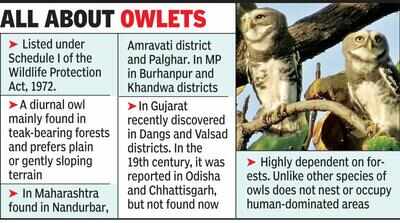- News
- City News
- nagpur News
- Colour-banding of owlets helps know movement pattern: Study
Colour-banding of owlets helps know movement pattern: Study

Nagpur: The colour-banding of 17 forest owlets in Melghat Tiger Reserve (MTR) has helped understand the endemic bird’s movement patterns, nesting and breeding ecology. This will be useful to the forest department in developing management guidelines and conservation action plan for owlets.
Talking to TOI on the eve of International Owl Awareness Day which falls on August 4, Prachi Mehta, senior scientist and executive director of Wildlife Research & Conservation Society (WRCS), said, “Colour-banding is one of the widely used methods in avian research and helps in monitoring the population of the species.”
Mehta, whose WRCS is implementing owlet research project since 2017 and is still going on, added, “Comparison of the ecology of the forest owlet with other co-existing owls will throw light on why the forest owlet is found in isolated populations, unlike other similar-sized owls. A final report on the research will be published soon.”
“In the next phase of the project which will start in September, we shall be studying a home range and habitat use of the forest owlet and other sympatric owls. This will help us to understand which specific areas are used by owl species for various activities,” Mehta said.
“Forest owlet is highly dependent on cavities for nesting and breeding success. If cavity-bearing trees are cut down, it can have serious repercussions on the future of forest owlets,” she says.
The study has found that its diet consists mainly of rodents. Therefore, owlets play a key role in controlling rodents, which harm agricultural crops. It also feeds on lizards and amphibians. Though it coexists with other small owls such as spotted owlet, jungle owlet, and Scops owl, the differences in their diet allow them to coexist with other owl species.
Mehta informed that WRCS work is also focusing on community-based conservation of owls and owl habitats in Melghat Tiger Reserve. With the participatory approach with the local community and support of the forest department, forest owlet and owl conservation actions will be implemented in Central India.
Talking to TOI on the eve of International Owl Awareness Day which falls on August 4, Prachi Mehta, senior scientist and executive director of Wildlife Research & Conservation Society (WRCS), said, “Colour-banding is one of the widely used methods in avian research and helps in monitoring the population of the species.”
Mehta, whose WRCS is implementing owlet research project since 2017 and is still going on, added, “Comparison of the ecology of the forest owlet with other co-existing owls will throw light on why the forest owlet is found in isolated populations, unlike other similar-sized owls. A final report on the research will be published soon.”
“In the next phase of the project which will start in September, we shall be studying a home range and habitat use of the forest owlet and other sympatric owls. This will help us to understand which specific areas are used by owl species for various activities,” Mehta said.
“Forest owlet is highly dependent on cavities for nesting and breeding success. If cavity-bearing trees are cut down, it can have serious repercussions on the future of forest owlets,” she says.
The study has found that its diet consists mainly of rodents. Therefore, owlets play a key role in controlling rodents, which harm agricultural crops. It also feeds on lizards and amphibians. Though it coexists with other small owls such as spotted owlet, jungle owlet, and Scops owl, the differences in their diet allow them to coexist with other owl species.
Mehta informed that WRCS work is also focusing on community-based conservation of owls and owl habitats in Melghat Tiger Reserve. With the participatory approach with the local community and support of the forest department, forest owlet and owl conservation actions will be implemented in Central India.
FacebookTwitterLinkedinEMail
Start a Conversation
end of article
Quick Links
Delhi Air PollutionDelhi TemperatureChennai WeatherBangalore TemperatureCovid vaccination centres in DelhiCoronavirus in DelhiRTPCR test in GurgaonHyderabad RainPollution level in BangaloreDelhi SmogDelhi TemperatureNoida AQIGurgaon AQI todayFire in MumbaiMumbai RainsCovid 19 RT PCR Test in NoidaDelhi AQI todaySrinagar encounter

